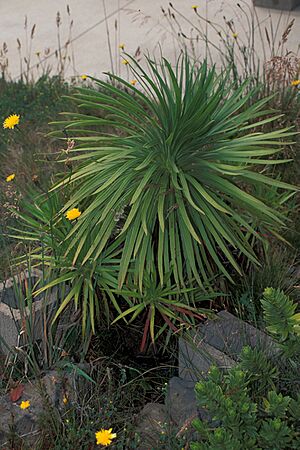Greensword facts for kids
Quick facts for kids Greensword |
|
|---|---|
 |
|
| The greensword plant | |
| Scientific classification | |
| Genus: |
Argyroxiphium
|
| Species: |
grayanum
|
The greensword (scientific name: Argyroxiphium grayanum) is a special kind of flowering plant. It belongs to the sunflower family, called Asteraceae. This plant is also part of a unique group of over 50 species known as the silversword alliance.
Plants in the silversword alliance look very different from each other. They also live in many different places. But they are all closely related by their genes. The greensword is a great example of how much these plants can change.
Some Argyroxiphium plants, like the famous Haleakala silversword and Mauna Kea silversword, live in very tough places. These are like alpine deserts with lots of heat, sun, wind, and dry air. These plants can store water in their leaves like a gel.
But the greensword (A. grayanum) is different. It lives in bogs, which are very wet areas. It likes lots of moisture, less sunlight, and cool temperatures. Its leaves are not designed to store water like the desert silverswords. They are more like the leaves of its relative, the Dubautia plant.
Contents
What is the Greensword?
The A. grayanum is a perennial plant, which means it lives for more than two years. It is endemic to the island of Maui in Hawaii. This means it is found naturally only on Maui.
This plant usually grows as a low shrub, up to 2 meters (about 6.5 feet) tall. It often has a single, upright stem with leaves arranged like a rosette. However, in the middle of bogs, it grows much smaller, usually under 30 centimeters (about 1 foot) tall.
Greensword Leaves and Habitat
The greensword has green leaves that are narrow and shaped like a tongue. They have 5 to 11 veins and are widest above the middle. You can find this plant only in and around montane cloud forest bogs. These bogs are found at high elevations, from about 1,200 to 2,050 meters (about 3,900 to 6,700 feet).
These areas get a lot of rain, from about 300 to over 1,000 centimeters (about 10 to 33 feet) per year! The greensword is most common along the top edge of Kīpahulu Valley on East Maui. It is also found near the top of Puʻu Kukui on West Maui.
Related Species: The ʻEke Silversword
The Puʻu Kukui region is also home to a related plant called the ʻEke silversword (A. caliginis). Even though they are closely related and live in the same area, these two species are different. The greensword has green leaves, while the ʻEke silversword has a special shiny look to its leaves.
How Greenswords Reproduce
Most Argyroxiphium species usually flower once and then the whole plant dies. But the greensword (A. grayanum) and the ʻEke silversword (A. caliginis) do not strictly follow this pattern.
These two species do not flower as often as the Haleakala silversword. Instead, they grow multiple branches. This means that only some parts of the plant die back each year after flowering, not the whole plant. The A. caliginis can also spread by sending out stems that root and grow new plants.
Other Greensword Species
There was another greensword species called A. virescens. It used to be found only on East Maui. Sadly, this species is now believed to be extinct.
Evolution of the Silversword Alliance
Scientists have studied the genes and biology of all the silversword alliance species. They believe that all these plants evolved from a single ancestor. This ancestor was likely related to a plant called the tarweed (Carlquistia muirii), which is found in western North America.
We know this because scientists have seen several natural hybrids (mixes) of these plants. This supports the idea that they all came from one original plant. If this is true, then the way the tarweed, silversword, and greensword plants changed into so many different forms and adapted to so many different places is an amazing example of adaptive radiation. This is a process where one group of organisms quickly evolves into many new forms to fill different ecological roles.


